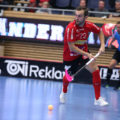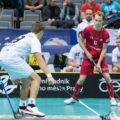The next weeks, we’ll have a few guest articles by David Schenker (Floorballytics), who will lead us through the world of analytics in floorball. David was assistant coach for SV Waldenburg Eagles, and, in 2017, he already wrote a few articles for FloorballToday (for instance: the differences in goal scoring in Sweden/Finland). Now there’s time to focus on analytics on club levels!
By: David Schenker (Floorballytics)
The saying „What you put in is what you get out“ is one hundred percent true in analytics, so if your standards and expectations are high, you are going to have to put in the work and time. The upside is that there are simple resources that don’t limit your possibilities, letting you decide how much is enough for you. I see many clubs making some use of video analysis and statistics, but how effective is it? Often the process is very time consuming, accessibility for the players is a hassle and the results are not very detailed. I’ll show you what you can gain from proper work with video analysis and statistics. If you want to take your coaching and the level of your team to the next level and you are serious about it, this might be for you.
First, let’s differentiate between in-game and post-game analysis. All my experience stems from post-game analysis, I have not tracked games while they are still ongoing. The tools I use support both aspects, so this doesn‘t mean that in-game tracking is not possible.
I work with a software called Performasports. It’s a sports video software analysis tool that allows you to break down video footage of your games and tag events and players. This is how I gather the data for my statistics, but also gives the player’s and staff the video footage of all the events tagged. Video sequences can easily be filtered by player or event type, pitch locations are also tracked. As the software is cloud-based, accessibility is very easy for coaches and players. Check out the software for free, and if you have any questions how it is used more specifically in floorball feel free to ask.
Try Performasports for free – Click here
Some of the stats that I track are common, some not so much. I will briefly get into some of the less known and give you some insight.
I track all shots for us and against us. The shots are then further split into shots on goal, blocked shots and missed shots. I use these numbers to calculate Corsi and Fenwick values for each player. If you don’t know these stats, they describe how many chances were created whilst a player was on the field, opposed to the chances that the opposition created while he was on.
Possession Differential is a stat that I haven‘t seen tracked anywhere. This stat provides a number that indicates whether a line was able to maintain or gain possession during their shift or if they had lost possession at the moment of the line change. This number can be provide some value, it also brings consciousness to the players to try and achieve a positive value.
I used the possession differential to keep track of the exact number of shifts played by each player. Special team shifts were added separately to the total as possession is not of indicative value there. Actual time played is very time consuming to track and I am not overly convinced of its added value. The number of shifts, which can then also be broken down on a per game basis across the whole season, give enough insight on player usage in my opinion.
Takeaways and giveaways are tracked, each player has a differential across the season and within every game. Whilst I think the stat is important, when using them for player feedback it is important to take a closer look at the occurrences. Deciding whether potential benefits outweigh the risk of losing possession is key.
Shooting percentage (how many of a player‘s shots on goal went in) is the more common of the two shooting stats that I use. The team’s shooting percentage also gives a nice indicator, when used in addition to reviewing shot location the stat becomes more applicable.
ShEff% is using shots on goal divided by all shot attempts (SOG/(SOG+SB+SM). Knowing the percentage of shots that are on goal is a stat I have found extremely helpful, this is tracked for the whole team and for individual players.
Defensive and Offensive Score are my overall performance indicators. In the course of a floorball game, many different events happen. In order to make use of all the tracked stats, I wanted to summarise a player‘s overall defensive play. All tracked actions for a player that affect the team‘s defensive performance influence the value of a player‘s defensive score. I borrowed the concept from NHL analyst Dom Luszczyszyn. After analyzing a game the tracked values are weighed, added up and give me a value for each player. I also used the same concept but different events to produce an offensive score for all players. These two scores then lead to a Gamescore Value for each player. These values provide quick insights into a players‘ performance. As always you need to look at numbers more closely if you want to really analyze performance, but I like the rough indication factor that it provides. It also leads to a healthy rivalry within the team to produce high Game Score values. Listed below are the tracked stats that influenced the values and how I weighed them (value of the stat multiplied by the weighing).

Are there things that need to be improved? Absolutely. Is this form of analytics the answer and key to success? I think if it is used properly it is a very nice piece to add to the puzzle. Considering the required know-how and the money it costs to produce these results I think many clubs that are aspiring for success could use some of these methods to improve their post-game analysis.
FloorballToday offer: Performasports gives the opportunity to try their software for three weeks – for free. Click here for a direct link.
The next week, this series will continue, with more information about player, team and goalkeeper statistics. Questions and/or feedback? Send Floorball Analytics a message on Twitter!









No Comments
Leave a comment Cancel